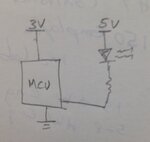ngmedaboard
Member level 3
- Joined
- Feb 7, 2010
- Messages
- 60
- Helped
- 7
- Reputation
- 14
- Reaction score
- 4
- Trophy points
- 1,288
- Location
- United States
- Activity points
- 1,831
I think I've answered this same question before but I forget the answer.
I want to confirm it's safe to sink a 5V powered LED through a 3V MCU.
Depending on how the output pins are pulled up or down, I'm concerned about seeing a small reverse leakage current when the output is high (3V) and the LED is tied to 5V. There should be very little current flowing other than leakage? Just want to make sure this is a safe configuration.

Thanks
I want to confirm it's safe to sink a 5V powered LED through a 3V MCU.
Depending on how the output pins are pulled up or down, I'm concerned about seeing a small reverse leakage current when the output is high (3V) and the LED is tied to 5V. There should be very little current flowing other than leakage? Just want to make sure this is a safe configuration.

Thanks